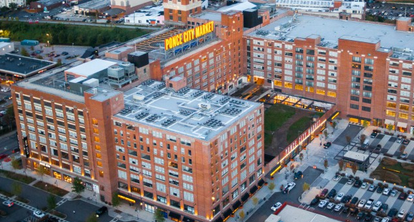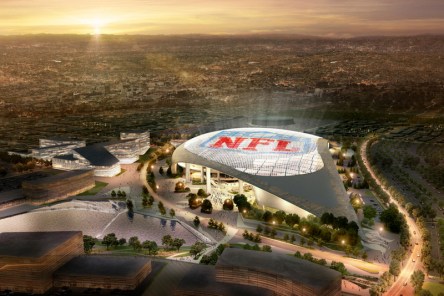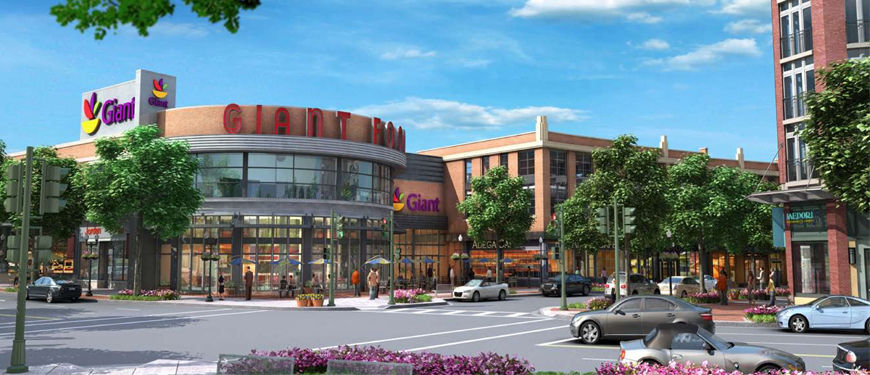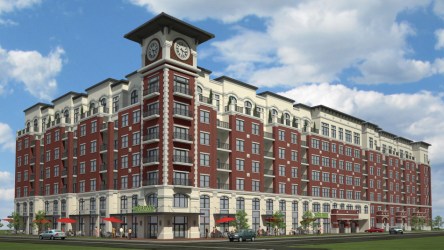An eye-catching yet awkward space may soon become Atlanta’s hottest new bar and lounge. The site of Ponce City Market was once home to Sears, Roebuck & Co. headquarters. When it opened in 1926, newspapers heralded the 2.1 million square-foot building as the largest brick structure in the southeastern United States for decades. It remained in operation until 1987. In 2012, the site reopened as a mixed-use hot spot for Atlanta locals and tourists alike. Nearly 85 businesses call Ponce City Market home. Restaurants, clothiers, bars, and artisanal shops share a space the buzzes with energy and young, hip shoppers. Though Ponce City Market has enjoyed success, its iconic tower remained desolate. Shops and restaurants occupied lower levels of the structure but the unique vision for floors 10, 10.5, 11, and 12 lingered unfulfilled. What Now Atlanta reports that operator Slater Hospitality has finally found a suitable use for the challenging 16,172 square-foot space. Plans for RFD Social are in the works. Rumor has it that RFD Social is short for Dinner Bell Radio Farmers’ Democracy, a radio show that once broadcast from the Atlanta Sears Tower in the 1920s. Kevin Slater, owner at Slater Hospitality, has not confirmed or denied this claim. RFD Social will include a multi-level bar and lounge, as well as an events space with a catering kitchen. Adjoining businesses include Skyline Park, Nine Mile Station restaurant, and Rooftop Terrace events space. While locals are excited to see the space put to good use, a few questions remain unanswered since the press release issued in late August. “I want to know if it will be a public space or if it will only be for private events,” said Kimmey Elliot, 26, an Old Fourth Ward resident. “We don’t need another...
NFL’s Hollywood Park...
Kickoff for Mixed Use
Designer HKS and developer Hollywood Park Land Company are changing the face of mixed-used facilities. The duo behind the Hollywood Park complex will tap into several revenue streams with a built-in consumer base. After more than a decade of anticipation, the 238-acre Hollywood Park project is finally underway with gusto. Ground broke back in 2014. It stalled and crawled until 2016. This year ushered in new developments. Revenue 1: Mixed-Use Commercial & Residential The 3 million square foot mixed-use property will include 620,000 square feet of retail space, and an unconfirmed quantity of townhomes and apartments, and a luxury hotel with stunning city views. Residents and guests will also have access to a new casino. The former Hollywood Park Casino will be demolished this October and replaced with an 110,000 square-foot facility. The JCJ Architecture design will include 125 card game tables, simulcast wagering, a lounge, a café, and a Century Bar & Grill sports bar. “This new casino was also designed with luxury and convenience in mind,” said Hollywood Park Casino General Manager Deven Kumar in a press release. “The new property will engage the art and social communities featuring global artists’ work throughout. […] Visitors will feel very safe, while enjoying themselves in beautiful surroundings.” Revenue 2: Creative Commercial Spaces To soften the edges of the manmade structures, designers added several green spaces throughout the site. A lake with water features will help to create a cool and calming vibe. These parks can provide rental opportunities for arts and cultural organizations; spaces for vendors with kiosks; and even creative advertising installations for landscaping, home and exterior furnishing companies. The stadium project is slated for completion in 2019 followed by the casino and “mini-city” in 2023. Revenue 3: NFL Gold Two sports teams...
A Winning Combo
Mixing Residential and Retail
The nation’s home ownership rate is on the decline as rising real estate prices and mortgage rates hold back demand. According to the latest data from the U.S. Census Bureau, the ownership rate dropped to 64.8 percent in the first quarter 2014 from 65.0 percent in the first quarter 2013 and 65.2 in the previous quarter. The rate is the lowest since the second quarter of 1995, when it was 64.7 percent. The Census report also shows that approximately 86.2 percent of the housing units in the United States in the first quarter 2014 were occupied and 13.8 percent were vacant. Owner-occupied housing units made up 55.9 percent of total housing units, while renter-occupied units made up 30.3 percent of the inventory in the first quarter 2014. Renting has started gaining ground mainly due to a combination of factors, including slow job growth, staggering economy, tight mortgage credit and declining affordability. In the first quarter 2014, the median asking rent for vacant for rent units was $766, whereas the median asking sales price for vacant for sale units was $139,200. Aside from the financial considerations, a lot of people turn to renting because of the flexibility that it entails. It’s no secret that young professionals follow the job trail and seek housing that best accommodates their lifestyle needs. Often times, this means that proximity to employment cores, recreational and shopping destinations, as well as sustainability, walkability and comfort turn into powerful retention drivers. While the Millennial generation remains the key renter demographic, baby boomers are expected to give a huge boost to the rental market, particularly due to the increasing number of empty-nesters who are looking to downsize and move into more sustainable homes. With consumer attitudes and habits on an ever-shifting path, the real estate landscape is bound to change as well. For the contemporary renter, mixed-use developments – usually retail and residential units wrapped around each other so as to offer a cohesive live-work-play environment – have become the place to be. Yardi client The Bozzuto Group, a Greenbelt, MD-based real estate services company, builds on such principles as quality, diversity, and inclusion and strives to deliver enhanced communities to cater to today’s most discerning renters – and all of this while respecting the world in which we live. The company’s newest mixed-use development in Washington, D.C., combines a premier location on stately Wisconsin Avenue with brilliantly designed residences and state-of-the-art retail. Dubbed Cathedral Commons, the project is a joint venture of Ahold USA, parent company of Giant Food, Bozzuto Development Company, and Southside Investment Partners of Baltimore. The boutique style building offers 138 apartment residences and eight townhomes which will be available in fall 2014. Among a series of upscale amenities, the property will feature a hotel-style lobby; fitness center; a library and conference room for private meeting space; resident lounge for hosted community social functions; rooftop deck and private outdoor courtyards; and a 24-hour concierge offering Bozzuto’s Top Notch services. Interiors will showcase contemporary design elements, including a chef-inspired kitchen with quartz countertops, custom oak flat-panel cabinetry, white beveled subway backsplashes and upgraded stainless appliances. Living spaces will include hardwood flooring and contemporary chrome LED track lighting, while bathrooms will boast Florentine Carrera floors and showers, chrome fixtures, and custom-designed vanities with integrated square sinks. The retail component, scheduled to begin delivering this fall, includes Barcelona Restaurant & Wine Bar, Raku, iDoc Optical, Wells Fargo, SunTrust, CVS Pharmacy, and Starbucks, as well as the 56,000-square-foot Giant Food, which will bring a new urban prototype concept to the project. H&R Retail handles leasing at the property. “We are excited to bring a mix of locally-based retailers and national brands to one of the most established and historic neighborhoods in the District,” said Toby Bozzuto, president, The Bozzuto Group. “Cathedral Commons and its new retail center will be vibrant, modern additions to Wisconsin Avenue and Northwest D.C....
Mills Properties
Developing mixed use in St. Louis
St. Louis isn’t known as a hipster haven. But the city’s developers are gradually embracing the concept of walkable urban neighborhoods. The reinvention of a portion of the city’s downtown, into what’s now known as the MX District, leads the way. MX stands for Mercantile Exchange, hearkening back to the days when downtown St. Louis was a commercial center. Yardi client Mills Properties was one of the first new developments to open its doors in the MX District when The Laurel apartments began leasing and welcoming residents in fall 2011. The Laurel, a mixed-use property with food and shopping on the ground floor, has attracted young professionals working in the biotechnology and medical fields, as well as students attending nearby colleges and universities. A popular local pizza joint, deli, wine bar and a restaurant serving Asian fusion cuisine are a major draw for residents, who enjoy a 10 percent discount on all purchases. The company has a second mixed-use project in progress that will feature a Whole Foods gourmet grocery on the ground level, and 177 apartments above. City Walk on Euclid will be located in the Central West End, and the Whole Foods will be St. Louis’ third such store. The Central West End has been a popular residential neighborhood since the 1904 World’s Fair, and City Walk residents will enjoy walkable access to a variety of restaurants and other amenities on Euclid. Mills Properties marketing manager Melissa DeCicco anticipates that the market’s widespread popularity will make walk-up leasing of the City Walk apartments as convenient as popping into Whole Foods for an easy deli-counter dinner. “I think we’ll have quite a few people right at the start of lease up who will want to be there because of the location, and Whole...




